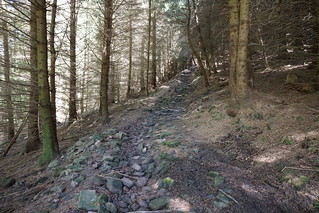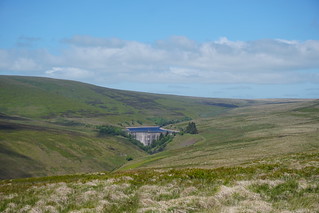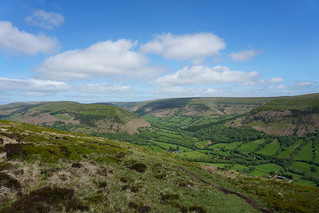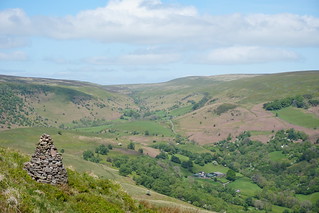Black Mountains Ridge Walk
Spectacular mountain ridge walk - Hay Bluff, Lord Hereford's Knob, & Waun Fach. Tough, with shorter easier options. Car only.

Ascending from Myndd Du car park in the Grwyne Fawr valley
swcwalks swcwalk339 52108559500




Ascending from the Vale of Ewyas to the "Offer's Dyke" path
swcwalks swcwalk339 52108301444
| Length |
Main Walk: 15.5 miles (24.9 km) with 3,550 feet (1,075 m) of elevation Vale of Ewyas circular (east) : ~15km with ~540m ascent Out-and back walks from Gospel Pass at 550m elevation
|
|---|---|
| Toughness |
10 / 10 for the main walk 3 / 10 for the Gospel Pass East and West short walks (some boggy terrain). 8 / 10 for the shorter "Vale of Ewyas" circular walk, which has a 'U' profile, with only 1 steep ascent/descent The ridge top paths are mostly maintained paths, with steps / stone slabs / gravel in places. But there are wet/boggy bits, even in dry weather. Waterproof mountain boots recommended. |
| Walk Notes |
The Black Mountains are at the eastern end of the Brecon Beacons on the England Wales Border. They are rounded grassy hills in a semi-circular ridge, rising to 800. There are 2 easy ridge walk options starting from Gospell Pass car park in the middle of the ridge at 549m, and a long strenuous circular walk combining all the main peaks. The eastern ridge walk, the "Offer's Dyke" path / Hatterrall ridge : Gospell Pass ( 549m ) - Hay Bluff ( 677m ) - Tyn Lech ( 703m ) - then a long gently descent The western ridge walk : Gospell Pass ( 549m ) - Lord Hereford's Knob ( 690m ) - Rhos Dirion ( 713m ) - Waun Fach ( 811m ) (Gospel Pass), Lord Hereford's Knob ( 690m ), & Waun Fach ( 811m ). Together, the 2 ridges form a 3/4 circle. The catch is that its an 'E' shaped mountain, i.e. 2 adjoining 'U' shaped valleys, so for a circular walk, you have 2 steep climbs and descents to do, not just one! As this makes for a long strenuous day, too long for many, a shorter walk is suggested. The long walk starts at a remote National Park car park, Myndd Du (Black Mountain in Welsh) at 1,300 feet, and climbs over a ridge (+250m, the middle of the 'E') to the neighbouring Ewyas valley at Capel-y-ffin (remote hamlet) at 1,000 feet. Here, the steep climb up to the "Offer's Dyke" path ridge starts (+320 m). Once up on the ridge, the remainder of the walk follows it in a long 3/4 circle. The ridge itself is treeless grassy open moorland over mostly maintained paths, but with boggy stretches inbetween. The "Offer's Dyke" section of the ridge forms the England Wales border. The path is well maintained, with steps across the wetter bits. After a a gentle walk north to Hay Buff, 677m (+80m via the highest point), the ridge turns west, and descends to Gospel Pass (549m), the highest road in Wales, and possible starting point. The ridge continues west over open moorland, and the path is eroded in places, wet even on dry days. Lord Hereford's Knob (690m, +140m) is close by, but after a short descent, its a long walk along the ridge gently ascending to Waun Fach (811m, +200m). From here, its a steep descent down to the Myndd Du car park. The shorter (but still long) circular walk Note this is the Black Mountains (plural) mountain range, at the eastern end of the Brecon Beacons National Park, which contains a top called Black Mountain (singular) / Twyn Lech. There is also a mountain range called Black Mountain (singular) at the western end of the national park. |
| Walk Options |
The 2 much easier out-and-back ridge walks starting from Gospell Pass, at 549m (1,801 ft!) the highest road in Wales. These are a delight as its only a short climb to the ridge. While fairly easy, the walks are still day walks rather than short walks.
The longer, harder circular walks
|
| Safety |
This is a very long remote walk over very exposed open moorland. The ony road access is at Gospel Pass. Check the weather before leaving home! Let someone know you are going! Take a survival bag, spare batteries and while navigation is easy, don't rely on your phone alone for navigation. |
| Travel |
Vale of Ewyas. The single track with passing places valley road runs from Hay-on-Wye in the north, via Capel-y-ffin and Llanthony (pub, ruined medieval priory) to the A465 (and Abergavenny) in the south.. Note: both places are in the same postcode - navigate by name instead when nearby
Grwyne Fawr valley
This walk can't be done by public transport. Hay-on-Wye (coach/bus only, no train station) in the north is too far from Gospel Pass to walk in, you'd have to take a taxi. From the south its 10 miles from Abergavenny station to Myndd Du car park, or 15 miles to Capel-y-ffin hamlet. |
| Vale of Ewyas |
If driving from the south long the 12 mile single track road to Gospel Pass, there is a ruined priory (free entry) and hotel/pub at Llanthony. The chapel in Capel-y-ffin is also worth a visit. |
| Eat |
Nothing on the walk. There is a hotel/pub in Llanthony, on the Vale of Ewyas valley road. |
| Stay |
There is a very small (max 3) mountain bothy, the southern most in the UK, at Grwyne Fawr, just north of the reservoir. Capel-y-Ffin Monastery is actually reasonably priced self-catering accomodation (rather than a ruined monastery). Abergavenny has a Premmier Inn, backpackers, and campsite. Hay-on-Wye has many places. |
| Brecon Beacons/Bannau Brycheiniog |
The Brecon Beacons/Bannau Brycheiniog National Park is in south Wales. It consists of bare, grassy, glacial mountains, with north facing escarpments. Its peaks, just shy of 1,000m (3,000ft), are the highest mountains in the southern UK. The national park is also noted for reservoirs, and the Dan yr Ogof caves. Its 4 mountain areas, from west to east are:
|
|---|---|
| Mountain Safety |
This is a challenging but achievable walk in good weather, even for young children, but it is in remote exposed mountain areas. It is possible to twist an ankle on any walk, and it will take hours for mountain rescue to drive to the trailhead, then climb the mountain, to reach you. So:
|
| Welsh Glossary |
aber: estuary, confluence, river mouth; afon: river; affwys: abyss; allt: hillside, cliff; aran: high place; ban/fan/bannau (pl): peak/beacon/crest, hill/mountain; big: peak; blaen: source of river, head of valley; bod: dwelling; bre: hill; bron: hill-breast; bryn: hill; bwlch: gap/col/pass; cadair: chair; cae: field; caer/gaer: stronghold, fort; capel: chapel; carn/garn/carnedd/garnedd: cairn, heap of stones, tumulus; carreg/garreg: stone, rock; castell: castle; cefn: ridge, hillside; celli: grove/copse; cerwyn: pot-hole; cist: chest; clog/clogwyn: cliff; clun: meadow; clwyd: hurdle/gate; clydach: torrent; coch/goch: red; coed: wood; craig/graig: rock; crib/cribyn: crest, ridge, summit; crug: mound; cul: narrow; cwm: hanging valley/corrie/bowl/dale; cyfrwy: ridge between two summits (saddle); ddinas: fort; dibyn: steep slope, precipice; dim: no; din: hill-fortress; disgwylfa: place of observation, look-out point; dôl: meadow; du/ddu: black, dark; dwfr/dŵr: water; dyffryn: valley; -dyn: fortified enclosure; eglwys: church; eira: snow; eisteddfod: meeting-place, assembly; esgair: ridge; fach/bach: small; fawr/mawr: large; fechan: smaller; ffald: sheep-fold, pound, pen, run; ffordd: way, road; ffridd: pasture; ffrwd: stream, torrent; ffynnon: spring/well; gallt: wooded hill; ganol: middle; garth: promontory, hill, enclosure; glan/lan: river-bank, hillock; glas: green (when referring to grass, pasture or leaves), blue (when relating to the sea or air); glyn: deep valley, glen; gors: bog; gorsedd: tumulus, barrow, hillock; gwyddfa: mound, tumulus; gwylfa: look-out point; gwyn/gwen: white; gwynt: wind; hafn: gorge, ravine; hafod: summer dwelling; hen: old; hendre(f): winter dwelling, old home, permanent abode; heol: road; hesgyn: bog; hir: long; is: below, lower; isaf: lower/lowest; llan: church, monastery; llawr: level area, floor of valley; llech: slab, stone, rock; llther: slope; lluest: shieling, cottage, hut; llwch: lake, dust; llwybr: path; llwyd: grey, brown; llwyn: bush, grove; llyn: lake; llynwyn: pool/puddle, moat; maen: stone; maes: open field, plain; mawn: peat; mawnog: peat-bog; melyn: yellow; merthyr: burial place, church; moel/foel: bare, bald/bare hill; mynydd: mountain, moorland; nant: brook/stream, dingle/glen; neuadd: hall; newydd: new; ogof/gogof: cave; pant: hollow; parc: park, field, enclosure; pen: head, top/end, edge; penrhyn: promontory; pentre(f): homestead, village; perfedd: middle; perth: bush, brake, hedge; plas: hall, mansion; pont/bont: bridge; porth: gate/gateway, harbour/bay/landing-place/ferry; pwll: pit, pool; rhiw: hill, slope; rhos: moor, promontory; rhudd: red, crimson; rhyd: ford; sarn: causeway; sgwd/rhaeadr: waterfall; sticill: stile; sych: dry; tafarn: tavern; tâl: end, top; talar: headland (of field); tan/dan: below; tarren/darren: escarpment; tir: land, territory; tor: break, gap; tre/tref: settlement, hamlet, town; twlch: tump, knoll; twll: hole, pit; tŵr: tower; twyn: hill; tŷ: house; uchaf: upper, highest; uwch: above, over; waun/gwaun: moorland, meadow; wen/wyn: white; y, yr, ‘r: the; ynys: island, holm, river-meadow; ysgol: ladder, formation on mountain-side/school; ysgwydd: shoulder (of mountain); ystafell: chamber, hiding-place; ystrad: wide valley, holm, river-meadow. |
| Profile | |
| Help Us! |
After the walk, please leave a comment, it really helps. Thanks! You can also upload photos to the SWC Group on Flickr (upload your photos) and videos to Youtube. This walk's tags are: |
| By Car |
Start Map Directions |
| Amazon | |
| Help |
National Rail: 03457 48 49 50 • Traveline (bus times): 0871 200 22 33 (12p/min) • TFL (London) : 0343 222 1234 |
| Version |
Oct-24 Andrew |
| Copyright | © Saturday Walkers Club. All Rights Reserved. No commercial use. No copying. No derivatives. Free with attribution for one time non-commercial use only. www.walkingclub.org.uk/site/license.shtml |





